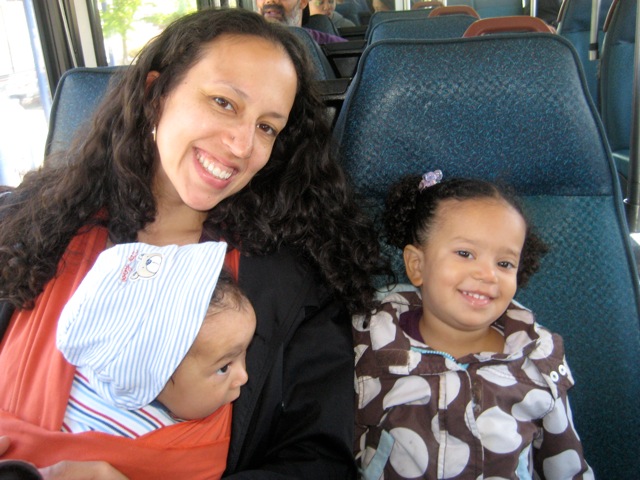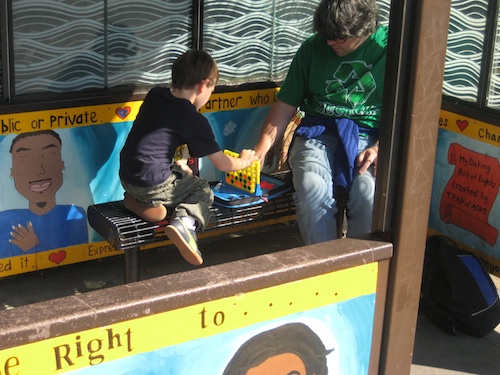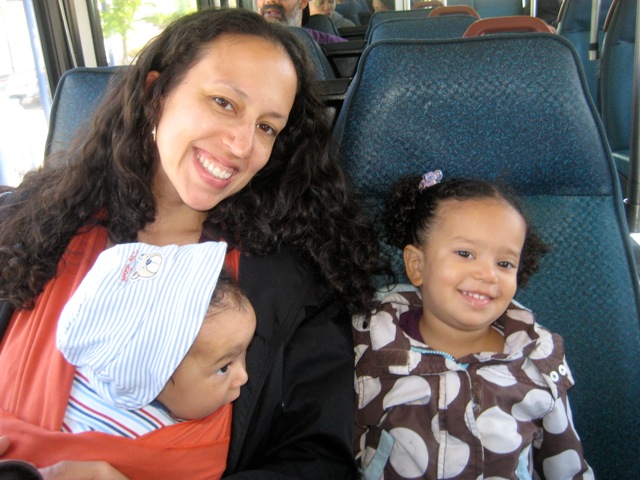 The wheels on the bus go ’round and ’round, and lead to happier kids.Photo: Carla SaulterEditor’s note: This is the first installment of a column about parenting in the city by Carla Saulter.
The wheels on the bus go ’round and ’round, and lead to happier kids.Photo: Carla SaulterEditor’s note: This is the first installment of a column about parenting in the city by Carla Saulter.
“The myth that good parenting means ferrying one’s children in the car prevents our seeing the alternatives.” — Carjacked: The Culture of the Automobile and Its Effect on Our Lives, by Catherine Lutz and Anne Lutz Fernandez
My husband, Adam, and I live in Seattle, in a (somewhat) dense, (fairly) walkable neighborhood. We have two children, ages nine months and (as of today) three years. We enjoy books and brunch and basketball. (Actually, we enjoyed basketball before David Stern and Clay Bennett stole our team, but that’s a topic for a different column.) We visit the Science Center and the Children’s Museum and, weather permitting, lots of beaches and parks. We attend church on Sundays. We practically live at the library. Oh, and we don’t own a car. On purpose.
Living without a car in Seattle, while not unheard of, is not especially common. For the entire eight years we’ve been together, Adam and I have been the only carfree people in our social circle. When we found ourselves (unexpectedly) expecting in early 2007, everyone we knew insisted that our admirable (if incredibly inconvenient and impractical) years-long “experiment” was over. Having kids, they knowingly informed us, means you have to have a car.
Of course that’s what they said. It’s become part of the collective American belief system that cars are the preferred (if not the only acceptable) mode of transportation for our children. Cars are now viewed as an essential tool of good middle-class parenting — both as a means of keeping our children safe from the evils of the outside world and of providing convenient access to the myriad destinations to which we are required to deliver them.
We didn’t buy a car. Since our daughter, Rosa, was born, three years ago today, we’ve been Metro parents. Rosa took her first bus trip home from the hospital at one day old and has ridden almost daily ever since.
What I’ve learned is that there are significant challenges to parenting without a car. This is not because there’s anything inherently unhealthy or inconvenient about taking kids on public transit, but because most U.S. cities, including mine, were built (or rebuilt) to accommodate cars. I’ve also learned that opting to continue our bus-based life was an excellent choice for our children’s health and well-being. Here’s why.
Cars are bad for kids
For one thing, cars discourage exercise. In an era of epidemic childhood obesity rates, everyone, from the school nurse to the first lady, is trying to get American children moving. And yet, the auto-centric built environment in many communities makes walking and cycling unpleasant, impractical, and quite often, dangerous. This encourages more driving, and probably explains why the majority of car trips are to destinations less than two miles away and why less than 15 percent of kids walk or bike to school.
Cars pollute the air kids breathe. Most of us know that cars degrade outdoor air quality wherever they exist. Most of us don’t know that the air inside cars is extremely unhealthy — especially for children. Air inside cars has significantly higher concentrations of carbon monoxide than the air directly outside of them. It’s better for a child’s lungs to stand on the shoulder of a freeway than it is to ride in the back seat of the family car — even before you account for the phthalates and PBDEs, which are associated with birth defects, early puberty, and impaired learning, from the materials used in their manufacture. (You can find these — and many other — facts about the health effects of cars in Carjacked.)
Perhaps most significantly, car crashes are the leading killer of American children. Cars are more deadly than any disease or other threat, and far more dangerous than buses or trains. When traveling to school, a child is eight times safer on a bus — even without belts or boosters — than in a car. Even when you factor in extremely rare instances of crime on transit, buses are still the safest way to travel on American roads. Which brings me to my next point …
Public transportation is good for kids
 Don’t try to do this while you’re driving.Photo: Carla SaulterIn a country where the majority of car trips are to destinations less than two miles away, a significant number of transit riders, including my barely three-year old daughter, walk two miles in the course of a normal day. According to a study by the University of British Columbia, public transit riders are three times more likely to meet the CDC’s daily exercise requirements than are their non-transit-riding peers.
Don’t try to do this while you’re driving.Photo: Carla SaulterIn a country where the majority of car trips are to destinations less than two miles away, a significant number of transit riders, including my barely three-year old daughter, walk two miles in the course of a normal day. According to a study by the University of British Columbia, public transit riders are three times more likely to meet the CDC’s daily exercise requirements than are their non-transit-riding peers.
When they’re not getting exercise, transit-geeks-in-training get attention. Parents on transit, freed from focusing on the road, can spend the ride interacting with their kids: reading, playing games (I once saw a father and son playing Connect Four at a bus stop), pointing out landmarks, or simply talking face to face. Not that kids who ride transit need much attention. They’re having too much fun. For kids on transit, the journey — Bells! Big wheels! Spinning seats! Turnstiles! Card readers! Automatic doors! — is at least as good as the destination.
As they grow up riding buses and trains, kids master the skills required to get around. They start small, like my daughter, who recently began carrying her own bag (a pink backpack with a train, per her request) and move on to stop recognition, schedule reading, and trip planning. Long before their peers are old enough to drive, junior transit riders have the skills to ride solo. The confidence that comes from these abilities will help them when they face problems mom and dad can’t help with.
And speaking of facing things … Kids who spend most of their time in controlled spaces — from home to car to school/mall/lesson/play date — have very limited contact with the people they share the world with. Kids who ride transit, on the other hand, have plenty of opportunity to interact with their fellow humans. They learn to accept differences, interact politely with strangers, and set and respect boundaries.
And sometimes, they get to sit next to an old man who makes origami cranes from old newspapers and passes them out to everyone within reach — just because.



